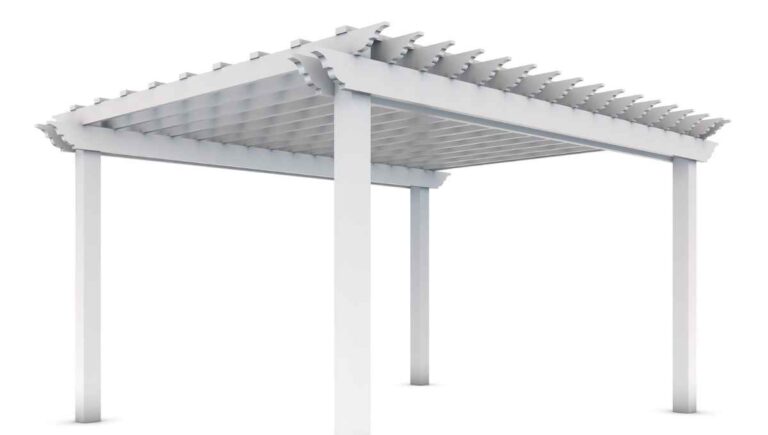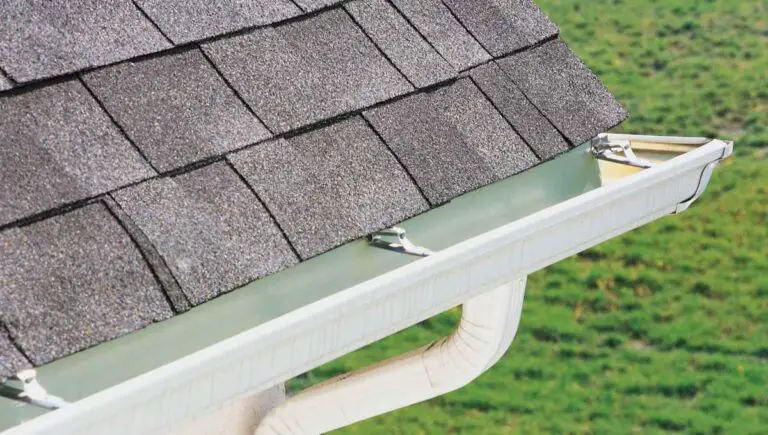Are Gazebos Safe in Wind? (7 Tips to Keep Them Secure)

Being worried about the safety of your gazebo during high winds is a completely valid concern. Besides, sometimes these structures are merely made out of vinyl and mesh that can certainly become airborne with the right gust of wind. So, are gazebos safe in the wind?
Gazebos are safe in the wind up to 30mph. If wind speeds become higher than this, you should begin securing your gazebo or take it down completely. This will prevent any damage to your gazebo and surrounding property.
A pop-up gazebo will by no means survive hurricane-force winds, but we have seven tips for you to try next time you’re under your gazebo and the wind picks up.
In this article, we’ll also discuss how to repair a tear in your gazebo.
This post contains affiliate links from Amazon and other stores. This means Yard Blogger may earn a commission if you make a purchase using any of our links. Please refer to our full affiliate disclosure policy for full details.
Here’s a Quick Pro Tip!
Even though a pop-up gazebo is not designed to withstand high wind speeds, there are methods to make it more secure. We recommend using these products together for the best possible protection.
Products to secure your gazebo:
1. Gazebo Weights: The best solution to adding weight to your gazebo to make it more secure.
2. Tent pens and ropes: Ideal to add tension to your gazebo’s legs.
3. Anchor pens: Could be used with tent pens for added security.
Are Gazebos Safe
Gazebos are excellent to protect you from the sun or rain. You’ll see multiple gazebos at sports or any outdoor events.
However, gazebos are not safe in high wind speed conditions. Let’s discuss why.
What Wind Speed Is Safe for a Gazebo?
Generally, most heavy-duty gazebos are able to withstand wind speeds of 30mph. The maximum wind speed that your gazebo can withstand depends on the type, quality, and durability of your gazebo.
If you notice wind speeds picking up and reaching 30mph you should collapse the gazebo.
These pop-up gazebos are generally used at sports events or when camping and are usually quite easy to take down or put up.
Is a Gazebo Better With Sides on or off in Wind?
The gazebo sides are great for privacy or shade but they can make your pop-up gazebo more susceptible to winds. Once the wind starts to pick up, you should open the side walls to prevent them from catching the wind.
The side walls could act like a sail on a sailboat and cause your gazebo to slide across the ground. Heavy-duty pop-up gazebos can generally withstand up to 30mph, but this is not a guarantee.
You will be able to notice if your gazebo can’t handle any more wind.
How Much Wind Can a Pergola Withstand?
If pergolas are secured enough, they can be considered hurricane-proof. Hurricanes can blow up to 150mph. The pergola should be in strong concrete foundations with metal bolts.
A pergola is a type of canopy that is generally used to form shade on a walkway or seating area.
It’s also generally made out of hardwood beams, making it easy for the wind to flow through the beams.
Are Gazebos Hurricane-Proof?
Even the most heavy-duty gazebos have their limits and would not be able to withstand hurricane-force winds. Permanent gazebos made of metal or wood, like pergolas, stand a much better chance to survive a hurricane.
This is because these ‘permanent’ gazebos are often securely fastened to the ground with concrete, weights, and other measures.
To prepare your gazebo for a hurricane you should make sure it is anchored to the ground. This applies for thunder storms, as well.
Should a Gazebo Be Open or Closed for High Winds?
A pop-up gazebo should be open during high winds, but a permanent gazebo (like a marquee) should be closed. The difference is that the pop-up gazebo is usually not securely anchored in the ground.
If you notice wind gusts picking up, the best option would be to take down your pop-up gazebo completely.
If that is not possible then you should open the sides and secure them with ground anchors.
When Should I Take My Gazebo Down?
A pop-up gazebo can usually withstand 30mph winds. Thus, if the wind (or wind gusts) are getting close to 30mph you should consider taking down your gazebo. There will also be some other signs that it’s time to take the gazebo down.
If your gazebo starts to lift off the ground slightly or if it moves an inch or two in a different direction, you can assume it is reaching the limit.
Rather take down your gazebo and put it up again when the wind subdues.
You might also enjoy our post on If Gazebos are Covered by Insurance
Can a Gazebo Withstand 40 Mph Winds?
Generally, a pop-up gazebo can withstand 30mph, but some heavy-duty gazebos will be able to withstand more. It depends on the quality of the material and how it is secured to the ground.
If you have a good quality gazebo and it is securely anchored to the ground, you can expect it to withstand 40mph, but not much more than that.
Permanent metal or wooden gazebos would be able to withstand much higher wind speeds.
How Do You Secure a Gazebo
Nobody wants to take down their gazebo when the wind blows. Luckily, it is quite easy to secure a gazebo.
In this section, we’ll discuss what products you can use to secure your gazebo against high wind speeds.
What Do You Do With a Gazebo in High Winds?
Using storm straps over your gazebo adds an extra layer of protection in addition to the tent pegs and ropes that come shipped with the gazebo. If you suspect the wind might be too strong and will damage your gazebo, rather take it down.
Keep an eye on the weather forecast on your phone, if the wind speeds are forecasted to pick up significantly you should ensure your gazebo is secure.
You could also attach sandbags or weights to the legs of your gazebo to increase the weight.
How Do You Protect a Gazebo Canopy From Wind?
To prevent your gazebo from being damaged by the wind you should open the vent at the top of your canopy and open your side walls of the gazebo. However, if the wind is more than 30mph, you should completely take down your gazebo to protect the canopy.
A pop-up gazebo canopy protects us from the sun and rain, but in most cases, it can’t protect us from the wind.
Canopies on pop-up gazebos can easily be damaged or torn by strong wind gusts, so you should use your own discretion to know when to take it down.
How Do I Stop My Gazebo Roof From Blowing?
You can use gazebo weights, which can be attached to your pop-up gazebo legs. These add extra weight to your gazebo and thus make it less likely that your gazebo roof will be damaged by high wind speeds.
Pop-up gazebos are designed to protect us from the sun or from rain. It’s not designed to be efficient in high winds.
If you notice wind speeds over 30mph and your gazebo roof starts to blow out, rather take the gazebo down.
How Do You Secure a Gazebo in High Winds?
Attach weights (of at least 40 pounds) to each leg of the gazebo. This will add substantial weight to your gazebo, therefore making it more secure. Alternatively, sandbags can also be used to add weight to your gazebo.
Here is a complete list of tips to secure your gazebo in high winds:
- Make sure the gazebo is on even, flat ground and near-natural windbreakers, like trees.
- Attach weights or sandbags to each leg of your gazebo.
- Anchor your gazebo legs with tent stakes and rope.
- Lift up the vent in the roof of your gazebo.
- Take off any side walls, the wind might damage these.
- Lower your gazebo as much as possible.
- If all else fails, take down the gazebo.
A pop-up gazebo is generally easy to put up or take down. Don’t risk the integrity of your gazebo in winds that it is not designed for.
How Do You Secure an Outdoor Gazebo?
To secure your outdoor pop-up gazebo you could add weights or sandbags to the gazebo legs. This will add a significant amount of weight and make it less susceptible to wind damage. You could also secure the legs using tent pens.
A pop-up gazebo is designed to be lightweight, easy to transport, and easy to set up.
However, it can be set up as a seasonal canopy in your backyard and it is possible to secure it against most natural elements (to a certain degree).
How Do I Make My Gazebo Wind Resistant?
We recommend reinforcing your gazebos’ legs with tent pens and heavy-duty ropes. Set up your gazebo near trees that could block most of the wind. The higher your canopy is, the more likely it is to get damaged in the wind.
It’s not really possible to make a pop-up gazebo completely wind resistant, but there are a few steps you could take to reduce wind damage.
We recommend having your gazebo on the lowest setting whenever the wind speed starts to increase.
You might also enjoy our post on If Gazebos Are Safe in Lightning
Do I Need to Anchor My Gazebo?
A gazebo should be anchored to prevent wind damage. If your gazebo is not anchored a small gust of wind could topple it over or cause it to move. Luckily it is quite easy to anchor your gazebo.
Most gazebos are shipped with tent pens and tropes, these should be enough to anchor your gazebo on a calm day.
You can anchor your gazebo in three easy steps:
- Take a hammer and drive the stakes into the ground.
- Attach the rope to the gazebo’s leg and to the stake
- Make sure there is tension in the rope.
Should I Ground My Gazebo?
A permanent metal gazebo should be grounded with copper rods. This prevents any damage to the frame when lightning strikes. A pop-up PVC gazebo however should not be up at all during lightning.
Even if you were to ground a pop-up gazebo, it would be destroyed if lightning hits it.
Therefore we advise you to take down your pop-up gazebo if it is safe to do so, before a lightning storm.
How Much Weight Do You Need to Hold Down a Gazebo?
Adding weight to a gazebo helps to keep it down during high winds. The exact amount of weight to add differs for each model and size, but a good estimate is 40 pounds (18kg) per leg.
So if your gazebo has four legs and you add 40 pounds of weight to each leg, you have a total of 160 pounds of extra weight to keep the gazebo down.
This prevents the gazebo from blowing up during wind gusts, to a certain degree.
How Do You Reinforce a Gazebo?
Use tent pens and straps to reinforce your gazebo. Drive the pens directly into the ground, and make sure the ground is not too loose (like sand). Adjust the strap so that it holds a lot of tension, this is what keeps your gazebo in place when the wind blows.
Pop-up gazebos are great for sports events or camping, but not always ideal for days with high wind speeds.
Luckily, you can reinforce your gazebos’ legs and add some extra weight to combat the wind.
Do Gazebo Weights Work?
Gazebo weights are well known for their ability to keep a popup gazebo firmly on the ground. Pop-up gazebos are designed to be lightweight and easy to travel with. This is very convenient but can become a problem when the wind starts to blow.
Adding at least 40 pounds of weight to each leg helps to increase the weight of the whole gazebo, and thus a light gust won’t be able to knock the gazebo over.
Using weights in combination with tent pens and ropes is a great way to secure your gazebo.
How Much Wind Can a Canopy Withstand?
An average pop-up gazebo can usually withstand 30mph winds, while heavy-duty gazebos can usually withstand more. This depends on the quality of the gazebo and also how well it is secured on the ground.
If your gazebo is secured on a flat piece of land, with tent pens and added weights, it should be able to withstand at least 30mph wind speeds.
Also, be sure to open the vent in the roof of your canopy and remove the side walls.
How Do You Keep a Gazebo Canopy From Tearing in the Wind?
Gazebo canopy tears in the wind when they’re put under a lot of tension. When this happens it usually means the wind is stronger than what the gazebo was designed to withstand.
Gazebo weights with a minimum weight of 40 pounds are the best solution to secure your gazebo from the wind. The heavier the weights the better.
However, if the wind picks up above 50mph you should take down your gazebo to prevent tearing.
How Do You Peg Down a Gazebo?
Add some gazebo weights and use tent pens and high-tension anchor ropes. Make sure you lower the canopy to the lowest setting or take it down completely in extreme conditions.
If you don’t have gazebo leg weights available you could also use sandbags in a pinch. It serves the same purpose, weights are generally easier to transport.
Also make sure your gazebo is on a flat, even surface and surrounded by some sort of natural barricade, like trees.
How Do You Repair a Gazebo
Leaving your gazebo up (secured or not) in extremely windy conditions could cause a tear. But, this doesn’t mean you should throw out your whole gazebo.
We’ll give you a few tips on how to repair your gazebo canopy.
Can You Fix a Broken Gazebo Roof?
You can fix a small tear in a polyester or nylon canopy gazebo with a patch of outdoor fabric, or even a patch from the same fabric on the side walls. This will work in a pinch, and it’s easy to attach.
Cut a patch that is slightly larger than your tear from a piece of outdoor polyester fabric. Spray some adhesive over the tear on your gazebo and place the patch on top.
You can patch both sides of the tear for more protection.
How Do You Repair a Tear in a Canvas Canopy?
It’s not all doom and gloom to repair a tear. You could use outdoor canvas fabric (available at most hardware stores) or even cut a piece of canvas cloth from your gazebo side wall. We don’t recommend doing the latter, but it works if you’re in a hurry.
Here are the exact steps to repair a canvas canopy:
- Cut a piece of canvas fabric that is slightly bigger than your tear.
- Clean the tear with rubbing alcohol.
- Spray adhesive spray over the tear and place the patch on top.
- You can repeat these same steps to add a patch to the bottom of the tear.
How Do You Repair a Nylon Canopy?
Clean the tear with some rubbing alcohol and then apply Tenacious Tape to the inside of the canopy. Then apply seam grip to the outside of the tend with a small brush or your finger. Allow it to dry for at least 24 hours and your gazebo canopy should be waterproof.
Some gazebos are made of nylon material, similar to the material that a tent is made of.
Following our steps above you can repair a nylon canopy, just be sure to trim any loose threads on the edges of the tear.
Related Questions
Can You Leave a Gazebo up Overnight?
If the weather forecast shows a calm night then you can absolutely leave your gazebo up overnight. However, if there are strong winds forecasted you might find your gazebo damaged the next day.
Pop-up gazebos are not designed to be left up in high wind speed conditions, so you need to be sure that your gazebo is secured.
You can secure your gazebo with weights added to the legs or additional tent pens and ropes.
Can You Put Gazebos on Concrete?
Gazebos can be put up on any flat surface, concrete included. Your gazebo should still be secured to the ground, even though you can’t drive tent pens through concrete. You can secure your gazebo with weights.
Weights of at least 40 pounds can be added to each leg to make the whole gazebo heavier and less likely to get wind damage.
Sandbags can also be used instead of weights, both work in a pinch.
Final Thoughts
Gazebos are essential for any sunny day outdoors, whether it be at the beach or next to the track.
We hope you found this information useful and next time it gets windy you know what to do to keep your gazebo safe.












